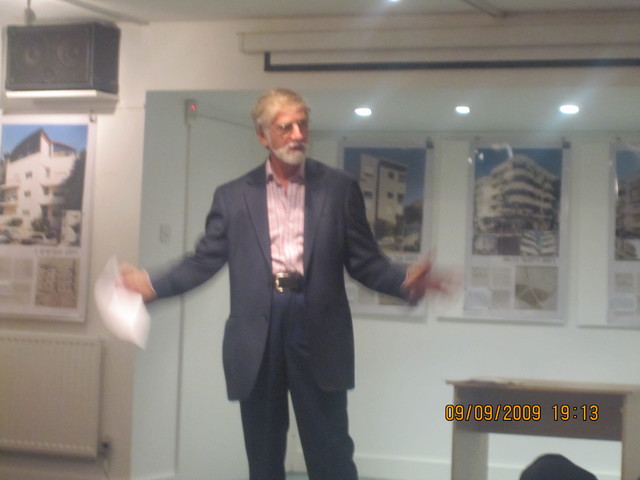During the 1920's and 1930's Tel Aviv saw the erection of the world's largest collection of buildings in the Bauhaus style which UNESCO has declared as being included in Worlds Cultural Heritage list. In the aftermath of the WW1 and during the 20's and 30's, Germany's economy was collapsing. Architect Walter Gropius was appointed to head the new institution that would help rebuild the country by creating a new style of building called Bauhaus. This intended to offer a fresh kind of residence representing a new social order for the working class. The style of the building would be free of any of previously designed architectural frills and unnecessary decorative details, promoting a rationalist socialist vision.
What typified the Bauhaus style were flat roofs, smooth facades and symmetrical cubic structures in white or light beige. The square shapes and right angles of the buildings themselves were often broken by round balconies. Since Bauhaus dealt with the art of simple and efficient living, everything in this style including furniture and utensils were designed to have clean lines and to be functional.
The Bauhaus style became exceptionally influential and was helped by the establishment of the Bauhaus school in Dessau developed by Walter Gropius and the famous Le Courbusier. In the school, renowned artists like Paul Klee and Wassil Kandinsky were also teaching.
With Hitler's ascent to power, the Bauhaus school was closed by the police on the orders of the National Socialist Party and many of the Jewish architects who were trained and taught there fled to Palestine and to the US and continued to design buildings in that style.
Since the Bauhaus style was connected with improving living condition of workers, in Palestine it tied in well with the ethos and the image of "the new Jew" versus the Diaspora Jews -- physically fit, working to build the country and through it to rebel against the image of the weak and poor Jew and his traditional occupations. These prevailing novel ideas of the early settlers found the Bauhaus concrete buildings and simple furniture adequate to serve their philosophy. It was also enhanced by the technical and engineering developments, allowing the walls to be built around steel and iron frames.
Tel Aviv was a new city with no tradition of building styles or concepts of aesthetics; it therefore lent itself easily to openness towards new fashions and styles. The spirit of the time was to enable the workers to enjoy the equality which previously they were denied. The Bauhaus blocks of apartments operated almost as self contained units often with services in the buildings themselves (such as laundry or small convenience stores). Each house had a plot of land which was left for people to grow their own vegetables -- as both the ideas of economical savings and bonding with the land were at the core of this enlightened planning.
In 1925 it was Patrick Geddes, a Scottish professor of Mines, who held the chair of Botany in the Art College of Dundee and who was the one who was asked by the Mandate authorities to plan the new city of Tel Aviv. His belief that there is a direct correlation between improvements in social processes and modes of living being surrounded by green was essential to his thinking. Therefore Tel Aviv was planned as a Garden City.
Incidentally, earlier in 1919 Geddes had been commissioned by the British Mandate to draw a master plan of expanding Jerusalem. Tel Aviv is the only city in the world whose core is entirely built according to one man, Geddes', plan -- the real predecessor of green policies in town planning. Geddes also fixed the main traffic routes through the city from north to south cutting throughout Dizengoff and Ben Yehuda streets, with which we are so familiar today.
There are 1500 Bauhaus International Style buildings are in Tel Aviv. They are marked for preservation and some have already been beautifully restored.
The name Tel Aviv is an interesting combination of two somewhat contradictory words: Tel = an ancient ground of layer upon layer of the ancient connection of Israel to its promised home; Aviv in Hebrew means spring time -- meaning that the bold historical site of ancient Israel is now given a renewal and fresh life. It was actually the translation of Theodor Herzl's title of his book ALTNEULAND ('old-new land' - translation into Hebrew by Nahum Sokolov), prophesying the establishing of the modern Israel -- haven for the Jewish people.
The Spiro Ark holds the sole rights in the UK to the internationally praised Bauhaus Exhibition of Tel Aviv created by the Bauhaus Centre in Tel Aviv. The exhibition includes 25 panels of Bauhaus buildings in the capital. It will open on the 9th September and will be displayed until the 15th October. During the exhibition the public will be treated to many unique events connected with this city, which will throw a new light on this dynamic city. Details which will be totally new to you, even if you are a frequent visitor and feel that you know it 'as the back of your hand'.
Events during the exhibition will include addresses by Linda Grant on 'Tel Aviv from the perspective of a Diaspora writer', Colin Shindler on 'The Unknown British Connection to the Creator of Tel Aviv', Dalia Lichfield on 'Tel Aviv from the Perspective of a Town Planner', Professor Joachim Schlör -- about the topic of his book 'Tel Aviv With Its Back to the Sea? Tel Aviv as a Port City', and an evening of 'Old Songs and Unknown Stories from the Early Days of Tel Aviv' presented by singer Norman Cohen Falah and actor Robert Rietti. In addition, we have organised two visits to houses which were built in Bauhaus style in London: '2 Willow Road' (30 September) and Dorich House in Kingston -- an example of 1930's modernism (12 October).
There will be as well screening of films. You can learn much more by contacting the Spiro Ark.
The Spiro Ark wishes to thank the Bauhaus centre in Tel Aviv, Doron Yacobi, Tetti Kadury, Howard Lewis, Tom Voute, Sylwia and Karolina, Professor Colin Shindler and all the many others who are donating their time to take part in this extraordinary month's programme.
If any provincial organization wishes to borrow this exhibition please contact our office for details.




